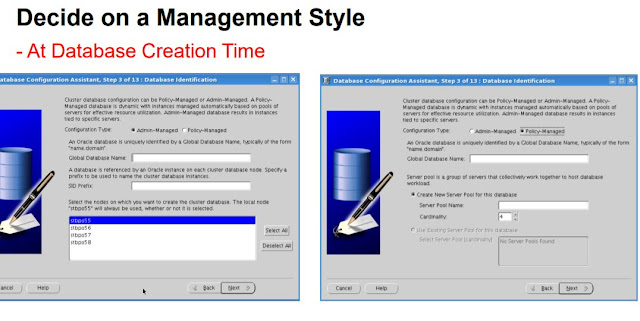In oracle Database 10g, we had only the first two automatic maintenance tasks mentioned below. With Oracle 11g, we have a third task name “Automatic SQL Tunning Advisor”
Automatic Optimizer Statistics Collection:
Automatic Segment Advisor:
Identifies segments that have space available for reclamation, and makes recommendations on how to de-fragment those segments.
Automatic SQL Tuning Advisor :
Examines the performance of high-load SQL statements, and makes recommendations on how to tune those statements.
To view the task, run the below SQL
SQL> select client_name from DBA_AUTOTASK_CLIENT;
CLIENT_NAME
----------------------------------------------------------------
auto optimizer stats collection
auto space advisor
sql tuning advisor
SELECT client_name, status, consumer_group, window_group
FROM dba_autotask_client
ORDER BY client_name;
CLIENT_NAME STATUS
---------------------------------------------------------------- --------
auto optimizer stats collection ENABLED
auto space advisor ENABLED
sql tuning advisor ENABLED
set line 400
col window_name format a20
select window_name,window_next_time from DBA_AUTOTASK_WINDOW_CLIENTS;
select window_name, REPEAT_INTERVAL, DURATION, NEXT_START_DATE from DBA_SCHEDULER_WINDOWS;
WINDOW_NAME WINDOW_NEXT_TIME
------------------------------ --------------------------------------
MONDAY_WINDOW 14-MAY-12 10.00.00.000000 PM EST5EDT
TUESDAY_WINDOW 08-MAY-12 10.00.00.000000 PM EST5EDT
WEDNESDAY_WINDOW 09-MAY-12 10.00.00.000000 PM EST5EDT
THURSDAY_WINDOW 10-MAY-12 10.00.00.000000 PM EST5EDT
FRIDAY_WINDOW 11-MAY-12 10.00.00.000000 PM EST5EDT
SATURDAY_WINDOW 12-MAY-12 06.00.00.000000 AM EST5EDT
SUNDAY_WINDOW 13-MAY-12 06.00.00.000000 AM EST5EDT
TEST_WINDOW 09-MAY-12 05.00.00.000000 AM EST5EDT
DBMS_SCHEDULER.set_attribute (
name => 'MONDAY_WINDOW',
attribute => 'repeat_interval',
VALUE => 'freq=daily;byday=MON;byhour=14;byminute=0;bysecond=0');
END;
/
BEGIN
DBMS_SCHEDULER.set_attribute (
name => 'TUESDAY_WINDOW',
attribute => 'repeat_interval',
VALUE => 'freq=daily;byday=TUE;byhour=14;byminute=0;bysecond=0');
END;
/
BEGIN
DBMS_SCHEDULER.set_attribute (
name => 'WEDNESDAY_WINDOW',
attribute => 'repeat_interval',
VALUE => 'freq=daily;byday=WED;byhour=14;byminute=0;bysecond=0');
END;
/
BEGIN
DBMS_SCHEDULER.set_attribute (
name => 'THURSDAY_WINDOW',
attribute => 'repeat_interval',
VALUE => 'freq=daily;byday=THU;byhour=14;byminute=0;bysecond=0');
END;
/
BEGIN
DBMS_SCHEDULER.set_attribute (
name => 'FRIDAY_WINDOW',
attribute => 'repeat_interval',
VALUE => 'freq=daily;byday=FRI;byhour=14;byminute=0;bysecond=0');
END;
/
BEGIN
DBMS_SCHEDULER.set_attribute (
name => 'SATURDAY_WINDOW',
attribute => 'repeat_interval',
VALUE => 'freq=daily;byday=SAT;byhour=14;byminute=0;bysecond=0');
END;
/
BEGIN
DBMS_SCHEDULER.set_attribute (
name => 'SUNDAY_WINDOW',
attribute => 'repeat_interval',
VALUE => 'freq=daily;byday=SUN;byhour=14;byminute=0;bysecond=0');
END;
/
To create a maintenance window, you must create a Scheduler window and then add it to the window group MAINTENANCE_WINDOW_GROUP
The DBMS_SCHEDULER PL/SQL package provides the ADD_WINDOW_GROUP_MEMBER subprogram, which adds a window to a window group
BEGIN
dbms_scheduler.create_window(
window_name => 'TEST_WINDOW',
duration => numtodsinterval(1, 'hour'),
resource_plan => 'DEFAULT_MAINTENANCE_PLAN',
repeat_interval => 'FREQ=DAILY;BYHOUR=5;BYMINUTE=0;BYSECOND=0');
dbms_scheduler.add_window_group_member(
group_name => 'MAINTENANCE_WINDOW_GROUP',
window_list => 'TEST_WINDOW');
END;
DBMS_AUTO_TASK_ADMIN PL/SQL package can be used to do the following.
To enable the task:
BEGIN
dbms_auto_task_admin.disable(
client_name => 'sql tuning advisor',
operation => NULL,
window_name => NULL);
END;
To enable it
BEGIN
dbms_auto_task_admin.enable(
client_name => 'sql tuning advisor',
operation => NULL,
window_name => NULL);
END;
Reference :
How to Change The Automated Maintenance Tasks Weekend Schedule (Doc ID 2036557.1)
